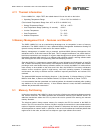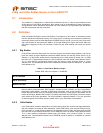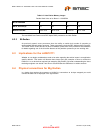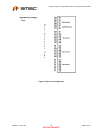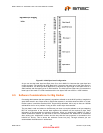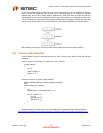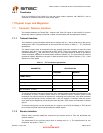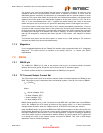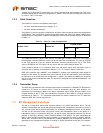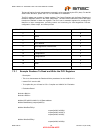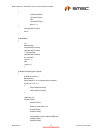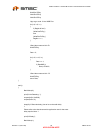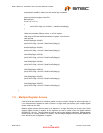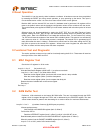
SMSC LAN91C111 32/16/8-Bit Three-In-One Fast Ethernet Controller
SMSC AN 9.6 43 Revision 1.0 (08-14-08)
APPLICATION NOTE
The receive input must be terminated with the correct termination resistance to meet the input
impedance and return loss requirements of IEEE 802.3. In addition, the receive TP inputs must be
attenuated. Both the termination and attenuation is accomplished with four external resistors in series
across the TPI± inputs. Each resistor should be 25% of the total series resistance, and the total series
resistance should be equal to the characteristic impedance of the cable (100 W for UTP, 150 W for
STP). It is also recommended that a 0.01 F capacitor be placed between the center of the series
resistor string and V
DD
to provide an AC ground for attenuating common mode signal at the input.
To minimize common mode input noise and to aid in meeting susceptibility requirements, it may be
necessary to add a common mode choke on the receive input. Common mode bundle termination may
be required and can be achieved by connecting the unused pairs in the RJ45 connector are connected
to chassis ground through 75 W resistors and a 1000 pF capacitor. A common mode AC ground return
path can be designed by connecting the center tap with a 75W resistor and capacitor to chassis
ground.
To minimize noise pickup into the receive path in a system or on a PCB, loading on TPI should be
minimized and both inputs should be loaded equally.
7.1.3 Magnetics
For the suggested Magnetics for the Twisted Pair interface refer to Application Note 8.13, “Suggested
Magnetics”. The latest revision is available on the SMSC web site , or contact your SMSC
representative.
7.2 RBIAS
7.2.1 RBIAS pin
The LAN91C111 RBIAS pin is used to set transmit current level. An external resistor connected
between this pin and ground will set the output current for the TP transmits outputs.
An 11Kohm resistor should be connected between the RBIAS pin and ground.
7.2.2 TP Transmit Output Current Set
The TPO± output current level is set with an external resistor connected between the RBIAS pin and
GND. This output current is determined from the following equation, where R is the value of RBIAS:
I
out
= (11K/R) I
ref
Where
I
ref
= 40mA (100Mbps, UTP)
= 32.6mA (100Mbps, STP)
= 100mA (10Mbps, UTP)
= 81.6mA (10Mbps, STP)
RBIAS should typically be an 11 kW 1% resistor to meet IEEE 802.3 specified levels. Once RBIAS is
set for the 100Mbps and UTP modes as shown by the equation above, I
ref
is then automatically
changed inside the device when the 10Mbps mode or UTP120/STP150 modes are selected.
Keep the RBIAS resistor as close to the RBIAS and GND pins as possible to reduce noise pickup into
the transmitter. Because the TP output is a current source, capacitive and inductive loading can reduce
the output voltage from the ideal level. Thus, in actual application, it might be necessary to adjust the
value of the output current to compensate for external loading. One way to adjust the TP output level
is to change the value of the external resistor connected to RBIAS. This value is PCB design
dependant, most be verified by designer.



